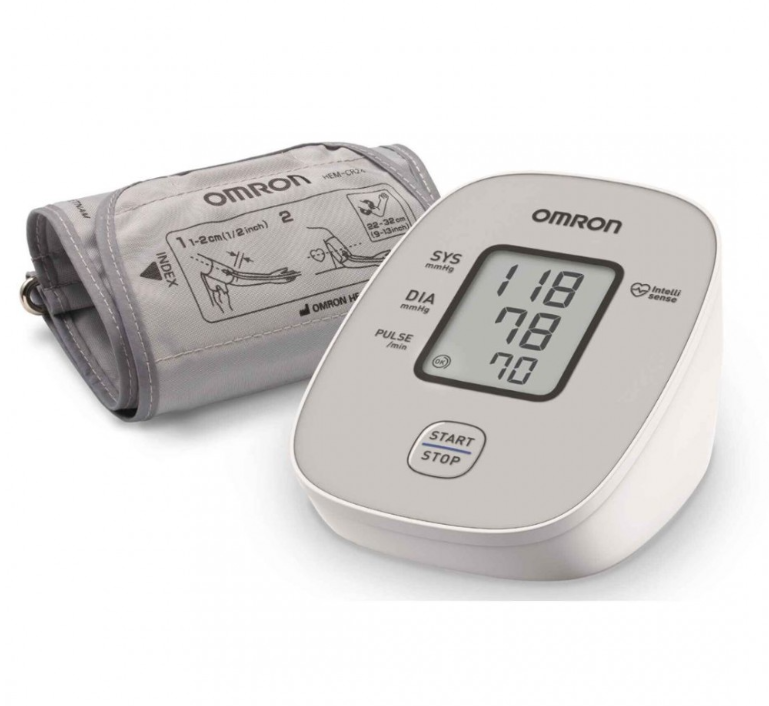
Do you know when and how to measure blood pressure? Discover everything!
Hypertension is a very common disease that affects millions of people around the globe. However, it is estimated that half of these people are unaware that they have high blood pressure. Why? It’s simple: since it’s a disease that doesn’t cause pain and there are no immediate symptoms, if regular measurements are not taken, high blood pressure is not diagnosed – and consequently, not treated.
In silence, high blood pressure wears down the human body and increases the likelihood of developing other coronary diseases, such as strokes or heart attacks. Therefore, even without visible symptoms, it is extremely important to maintain a preventive attitude towards blood pressure by adopting healthy lifestyle habits and engaging in physical exercise. But after all, what is blood pressure?
What is blood pressure?
Throughout the 24 hours of our day, the heart never stops. Its function is, with each heartbeat, to pump blood so that it circulates through the arteries, carrying oxygen and nutrients to all cells of our body. The pressure at which blood circulates within the arteries is called Blood Pressure. It is this pressure that ensures that blood circulates properly throughout the body.
What are the normal values of blood pressure?
The measurement of Blood Pressure is based on two parameters: the maximum – or systolic – blood pressure, and the minimum – or diastolic – blood pressure.
The Minimum Arterial Pressure corresponds to the pressure exerted on the walls of the arteries during the heart’s rest between heartbeats. The Maximum Arterial Pressure is the one exerted on the walls of the arteries with each heartbeat.
Normal Blood Pessure is considered when the maximum blood pressure is between 12 and 13 mmHg, and the minimum blood pressure is between 8 and 8,5 mmHg.
Variations in Blood Pressure
And when the values do not correspond to the normal parameters?
When the measured values are significantly below or above the considered normal values, it could be one of two scenarios:
HYPOTENSION
In these cases, what happens is that the blood flow doesn’t have enough force to reach the entire body and transport oxygen and nutrients to all cells, affecting the proper functioning of some organs – leading to drops in blood pressure. This condition can be associated with a range of causes, including heart failure, dehydration, blood loss, excessive medication, nervous system disorders, among others. It’s also a recurring issue during pregnancy. In most cases, drops in blood pressure are accompanied by symptoms such as dizziness, blurred vision, and fainting.
Hypotension is Low Blood Pressure when the measured values are below 9/5 mmHg. The treatment for hypotension is based on medication prescription and the adoption of a healthier lifestyle, allowing blood pressure to rise to normal values.
HYPERTENSION
Hypertension is High Blood Pressure when the measured values are above 14/9 mmHg, and it’s a condition that affects a large number of people worldwide.
At its root, it can have various causes: infections, kidney diseases, diabetes, unhealthy lifestyle habits, obesity, among others. There are two types of hypertension: primary, which increases with age and is not associated with any specific cause, and secondary, which is caused by an underlying condition and tends to appear suddenly, being more common in younger ages.
In most cases, hypertension is asymptomatic. The treatment is based on medication prescription and the adoption of a healthier lifestyle, allowing blood pressure to lower to normal values.
Is it important to measure blood pressure regularly?
For a healthy individual, there’s no need to measure blood pressure very regularly. Blood pressure should be measured annually, along with other routine clinical examinations recommended for adults. However, individuals with diabetes or with renal, cardiac, or neurological pathologies should do it more regularly, according to the doctor’s instructions.
Unless requested by a healthcare professional, there is no benefit in very frequent blood pressure measurements. On the contrary, it can be a source of anxiety and worry.
Nevertheless, since hypo and hypertension are diseases that do not cause pain, diagnosing them in a timely manner is crucial to ensure early and effective intervention. So, maintain a preventive attitude and monitor your blood pressure.
The “White Coat Effect”
Surely it has happened to you – or you know someone to whom it has happened – to go to the doctor, measure blood pressure, and the values are high. These cases are known as the ‘White Coat Effect,’ and what happens is that the patient has isolated high blood pressure when they are in the doctor’s office, but outside of the office, their blood pressure values are always normal. In many cases, when hypertension is detected during the appointment, unnecessary medication is prescribed, which then brings other implications in the patient’s daily life.
Therefore, to avoid unnecessary medication administration, doctors have been avoiding blood pressure measurement during appointments and advising that it be done at home, in a calm and quiet environment, with a blood pressure monitor. If the values recorded at home are indeed abnormal, then the doctor may prescribe the most appropriate medication. But how to measure blood pressure correctly at home?
How to measure blood pressure correctly?
If you are going to measure blood pressure at home using a blood pressure monitor, we provide you with an Essential Guide on how to do it. First of all, when should the measurement be taken?
- In the morning, take the measurement upon waking up, before any medication and on an empty stomach.
- At night, take the measurement at least two hours after dinner and before going to bed.
Before the Measurement
- Preferably, take the measurement directly on the skin, without clothing on the arm area.
- Sit comfortably with your back supported and in a relaxed and rested position.
- Do not measure blood pressure if you are experiencing any emotional disturbance or physical alteration (such as needing to use the bathroom, for example).
- Do not smoke or drink coffee or other stimulant beverages at least one hour before taking the measurement.
How to make the correct measurement with a blood pressure monitor?
To make the correct measurement of blood pressure using a blood pressure monitor with an arm cuff, you should:
- Place the cuff (which should be suitable for the diameter of your arm) about 2 to 3 centimeters above the elbow.
- Support the arm so that the cuff is at the level of the heart and never below it.
- Press the button to start the measurement on the device and remain still and relaxed throughout the process until the device displays the final readings. Avoid talking or crossing your legs during the process.
For accurate and reliable readings, it’s ideal to take three measurements spaced one to two minutes apart. The first measurement should not be taken into account, and only the last two should be recorded for monitoring purposes.
Is your Blood Pressure outside the normal range for the first time?
If you measured your blood pressure following our tips and the readings are outside the normal range, it’s important to note that a single measurement is not enough to diagnose hypo or hypertension. After detecting abnormal readings, you should adopt a preventive approach and measure your blood pressure more frequently in the coming days. If the anormal readings persist, consult your doctor and follow their advice.
Types of Blood Pressure Monitors
Blood Pressure Monitors can be of two types: arm cuff – or brachial cuff – and wrist cuff. These two types differ mainly in how they are used and where they are placed to take the measurement.
ARM BLOOD PRESSURE MONITOR
It is placed on the arm, usually at the level of the heart. It is more accurate and more recommended for reliable measurements. It is more comfortable, especially if the person has circulation issues in the hands or wrist.
WRIST BLOOD PRESSURE MONITOR
It is placed on the wrist and is more compact and portable. It is more convenient for travel or occasional use, but it can be less accurate, especially if not used correctly or if the wrist isn’t in the proper position during measurement.
What are the best Blood Pressure Monitors?
Generally, arm blood pressure monitors are more reliable. So if you’re buying a new blood pressure monitor, choose an arm cuff model.
Another crucial factor when choosing a blood pressure monitor is to opt for one that has been tested and validated to accurately measure blood pressure at home, providing exact and reliable results. This is what sets OMRON Blood Pressure Monitors apart from the rest: the monitors from Loja Ortopédica are verified, meaning they are calibratable. In addition, this is a brand recommended by doctors, with a 3-year warranty and calibration service, which can be done at Loja Ortopédica — with a calibration seal.
OMRON M2 Arm Blood Pressure Monitor
The OMRON M2 Basic Arm Blood Pressure Monitor is a model that allows for precise, quick, and comfortable measurement of blood pressure. This advanced model also detects irregular heartbeats and prevents excessive inflations, ensuring greater comfort. Its large screen and ease of use make it especially suitable for elderly individuals, who can take measurements with just one touch.
OMRON M3 Comfort Arm Blood Pressure Monitor
Fully automatic, the OMRON M3 Comfort Arm Blood Pressure Monitor operates on the oscillometric principle. It measures blood pressure and pulse in a simple and intuitive manner. Its inflation is comfortable and automatically controlled thanks to its advanced technology, which accurately assesses arm size for reliable results. It can store data for two different users, allowing each person’s readings and trends to be tracked. It comes with a 3-year warranty and certified equipment calibration.
OMRON RS2 Wrist Blood Pressure Monitor
A kind of two-in-one device, the OMRON RS2 Wrist Blood Pressure Monitor is the tool that will help you prevent health problems. With a unique set of features, this monitor provides a range of additional important information about your health status. It includes a high blood pressure indicator that lights up if blood pressure exceeds the levels recommended by the World Health Organization, as well as an irregular heartbeat detector.
Healthy Lifestyle
Preventing the onset of blood pressure-related diseases is possible. Part of this effort involves adopting healthy lifestyle habits and engaging in physical exercise. If you’re not sure how to start exercising, read our article “How to Start Playing Sports?”
In addition, there are some recommendations you should follow in your routine to prevent the development of these (and other) diseases:
- Adopt a diet with low salt (five to six grams/day) and fat content;
- Adopt a diet rich in fruits and vegetables;
- Don’t smoke;
- Exercise regularly;
- Avoid excessive alcohol consumption.
If you still have questions about how to measure blood pressure, how to calibrate your blood pressure monitor, or which model best suits your needs, get in touch with us!
If you’re having trouble choosing the best product for yourself or a family member, or want to know which option best meets your needs, talk to our specialized professionals, who are always available to help and advise you.
We know and have what you need!







No Comments